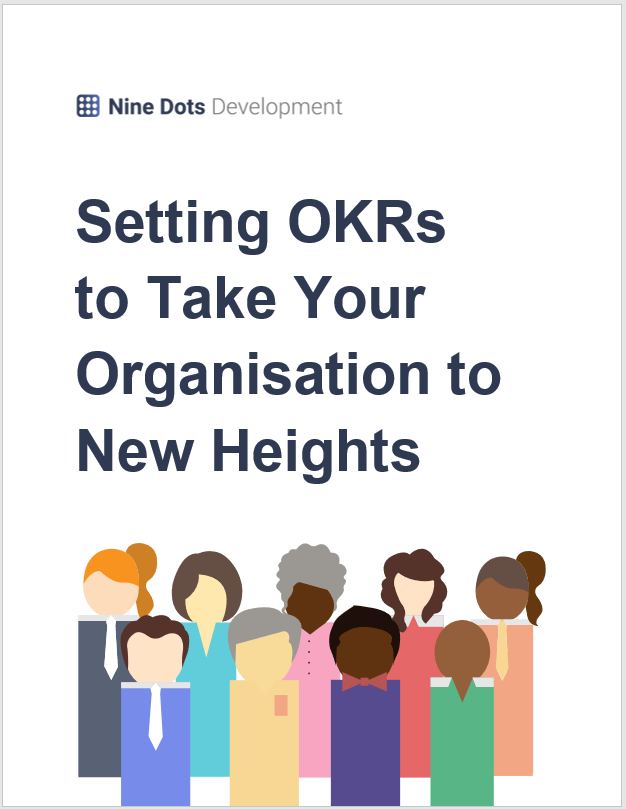Wednesday 16 Jun 2021 Article
The TakeawayYour Guide to the Goal-Setting Methodology That Took Google to New Heights
Setting Your Strategic Plans into Motion
Part 1 of 3
#Guide #StrategicPlans #OKRs #GoalSetting #PersonalDevelopment
The perfectly matched resource for this article...
Download Our Free 'Setting OKRs to Take Your Organisation to New Heights' Guide!
Please click below to download our free 'Setting OKRs to Take Your Organisation to New Heights' Guide!
Download our free guide!Playing catchup?
Your Guide to the Goal-Setting Methodology That Took Google to New Heights
Do you want to take your organisation to a level of success that it’s never seen before?
The OKR Goal-setting Methodology can help you do exactly that!
So what are OKRs, how do they work, and how can you adopt them to take your organisation to new heights?
The History of OKRs and Their Success
OKRs were first invented and implemented by Andy Grove at Intel in 1971.
Since then, countless organisations have adopted OKRs, including LinkedIn, Spotify, Twitter, BMW, Disney, Samsung, and most famously – Google.
Google was the 18th search engine company to come onto the web, so it seemed unlikely that they would ever become a market leader, but Google defied the odds and is now the most popular search engine company.
Google did this by implementing OKRs.
So What Actually is an OKR?
OKRs are a collaborative goal-setting methodology that “helps ensure the company focuses efforts on the same, important issues throughout the company”.
They encourage growth, improvement and innovation by allowing teams and individuals to set challenging, ambitious goals and actually meet them.
OKRs are broken down into two parts; Objectives and Key Results.
Objectives are “what is to be achieved; no more, no less”. They should be “significant, concrete action-orientated and ideally inspirational”.
Each objective should then have 2-5 Key Results.
Key Results “benchmark and monitor how we get to the objective”. They should be “specific, time-bound, measurable and verifiable”.
Put simply, the Objective is what we want to achieve and the Key Results are how we plan to achieve it.
Why Are OKRs So Popular and Widely-used?
OKRs are used by so many companies worldwide because they bring so many benefits.
For example, OKRs:
- Help you track your progress towards your goals
- Create alignment between individuals’ goals and your organisation’s goals
- Encourage employee engagement
- Eliminate ambiguous goals
- Help staff prioritise tasks
- Bring clarity to the goal-setting process
- Increase buy-in to goals and changes
- Help create a more proactive and forward-thinking company culture
- Hold you and your employees accountable
- Make implementing changes in your organisation easier
Ownership mentality is key to having a dedicated, self-motivated and productive workforce.
It is formed when everyone believes that what they are doing is important and they know how their role connects with the bigger picture – OKRs connect the dots between individuals’ jobs and the organisation’s strategy.
The beauty of the OKR Goal-setting Methodology is that it is very simple, and can be applied to almost any person, in any role, at any company.
How Can You Adopt OKRs in Your Organisation?
Setting OKRs is really quite simple, and only consists of 3 main steps:
- Leaders define overarching objectives for the company
- Teams/departments then write their own OKRs that contribute to the overarching objectives
- These OKRs are then cascaded into individuals’ OKRs
OKRs can vary in duration, but it is recommended that you set three OKRs each quarter.
The key thing to remember is that OKRs shouldn’t include day-to-day responsibilities, they should focus on new tasks and initiatives that drive your organisation forward.
You can click here to download our free, more in-depth guide to ‘Setting OKRs to Take Your Organisation to New Heights’, which also includes great examples of OKRs.
Once you have set your OKRs, it’s important to regularly and frequently review them to make sure that they are still relevant to where your organisation is headed and to check that your staff are on track to meeting their objectives.
---
Tomorrow on The Daily Dot, we will be looking at the Urgent/Important Matrix and how you can decipher what tasks you should actually be prioritising over others, so stay tuned!
Download Our Free 'Setting OKRs to Take Your Organisation to New Heights' Guide!
Please click below to download our free 'Setting OKRs to Take Your Organisation to New Heights' Guide!
Download our free guide!Missed an article?
More from Setting Your Strategic Plans into Motion
